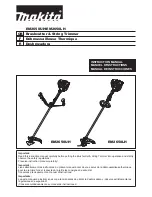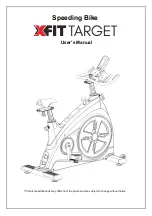
Checking the Interlock
Switches
Service Interval:
Before each use or daily
CAUTION
If safety interlock switches are disconnected or
damaged the machine could operate unexpectedly
causing personal injury.
•
Do not tamper with the interlock switches.
•
Check the operation of the interlock switches
daily and replace any damaged switches before
operating the machine.
The machine has interlock switches in the electrical system.
These switches are designed to stop the machine when the
operator gets off of the seat when the traction pedal is
depressed. However, the operator may get off of the seat
while the engine is running and the traction pedal is in neutral.
Although the engine will continue to run if the PTO switch
is disengaged and the traction pedal is released, it is strongly
recommended that the engine be stopped before rising from
the seat.
To check the operation of the interlock switches, perform
the following procedure:
1.
Drive the machine slowly to a large, relatively open
area. Lower the cutting unit, stop the engine, and apply
the parking brake.
2.
Sit on the seat and depress the traction pedal. Try to
start the engine. The engine should not crank. If the
engine cranks, there is a malfunction in the interlock
system that should be corrected before beginning
operation.
3.
Sit on the seat and start the engine. Rise from the seat
and move the PTO switch to On. The PTO should
not engage. If the PTO engages, there is a malfunction
in the interlock system that should be corrected before
beginning operation.
4.
Sit on the seat, engage the parking brake and start the
engine. Move the traction pedal out of the neutral
position. The InfoCenter will display “
traction
denied
” and the machine should not move. If the
engine does move, there is a malfunction in the
interlock system that should be corrected before
beginning operation.
Pushing or Towing the
Machine
In an emergency, the machine can be moved forward by
actuating the bypass valve in the variable displacement
hydraulic pump and pushing or towing the machine.
Important:
Do not push or tow the machine faster than
3-4.8 km/h (2-3 MPH) because internal transmission
damage may occur. The bypass valve must be open
whenever the machine is pushed or towed.
Important:
If the machine must be pushed or towed
in reverse, the check valve in the four-wheel drive
manifold must also be bypassed. To bypass the check
valve, connect a hose assembly (Hose Part No. 95-8843,
Coupler Fitting No. 95-0985 [Qty. 2], and Hydraulic
Fitting No. 340-77 [Qty. 2]) to the reverse traction
pressure test port, located on the hydrostat, and on the
port located in-between ports M8 and P2 on the rear
traction manifold which is located to the inside of the
front rear tire.
1.
Open the hood and locate the bypass valves (
Figure 20
)
on the top of pump, behind the battery/storage boxes.
2.
Rotate each valve 3 turns counter-clockwise to open
and allow oil to bypass internally.
Do not open
more than 3 turns.
Because fluid is bypassed, the
machine can be slowly moved without damaging the
transmission.
Figure 20
1.
Bypass valve (2)
3.
Close the bypass valves before starting the engine.
Torque to 70 N-m (52 ft-lb) to close the valve.
Jacking Points
•
Always use jack stands. Do not rely on a jack or hoist
to hold the machine.
•
On the front of the machine on the frame on the inside
of each drive tire
•
On the rear of the machine at the center of the axle
Tie Downs
•
Use properly rated DOT approved straps in four corners
to tie down machine.
28
Содержание Groundsmaster 4500-D
Страница 54: ...Notes 54 ...
















































